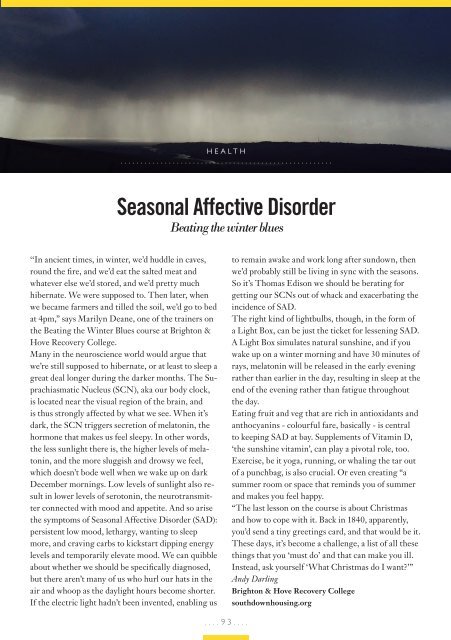Viva Brighton Issue #46 December 2016
You also want an ePaper? Increase the reach of your titles
YUMPU automatically turns print PDFs into web optimized ePapers that Google loves.
HEALTH<br />
.....................................................<br />
Seasonal Affective Disorder<br />
Beating the winter blues<br />
‘‘In ancient times, in winter, we’d huddle in caves,<br />
round the fire, and we’d eat the salted meat and<br />
whatever else we’d stored, and we’d pretty much<br />
hibernate. We were supposed to. Then later, when<br />
we became farmers and tilled the soil, we’d go to bed<br />
at 4pm,” says Marilyn Deane, one of the trainers on<br />
the Beating the Winter Blues course at <strong>Brighton</strong> &<br />
Hove Recovery College.<br />
Many in the neuroscience world would argue that<br />
we’re still supposed to hibernate, or at least to sleep a<br />
great deal longer during the darker months. The Suprachiasmatic<br />
Nucleus (SCN), aka our body clock,<br />
is located near the visual region of the brain, and<br />
is thus strongly affected by what we see. When it’s<br />
dark, the SCN triggers secretion of melatonin, the<br />
hormone that makes us feel sleepy. In other words,<br />
the less sunlight there is, the higher levels of melatonin,<br />
and the more sluggish and drowsy we feel,<br />
which doesn’t bode well when we wake up on dark<br />
<strong>December</strong> mornings. Low levels of sunlight also result<br />
in lower levels of serotonin, the neurotransmitter<br />
connected with mood and appetite. And so arise<br />
the symptoms of Seasonal Affective Disorder (SAD):<br />
persistent low mood, lethargy, wanting to sleep<br />
more, and craving carbs to kickstart dipping energy<br />
levels and temporarily elevate mood. We can quibble<br />
about whether we should be specifically diagnosed,<br />
but there aren’t many of us who hurl our hats in the<br />
air and whoop as the daylight hours become shorter.<br />
If the electric light hadn’t been invented, enabling us<br />
to remain awake and work long after sundown, then<br />
we’d probably still be living in sync with the seasons.<br />
So it’s Thomas Edison we should be berating for<br />
getting our SCNs out of whack and exacerbating the<br />
incidence of SAD.<br />
The right kind of lightbulbs, though, in the form of<br />
a Light Box, can be just the ticket for lessening SAD.<br />
A Light Box simulates natural sunshine, and if you<br />
wake up on a winter morning and have 30 minutes of<br />
rays, melatonin will be released in the early evening<br />
rather than earlier in the day, resulting in sleep at the<br />
end of the evening rather than fatigue throughout<br />
the day.<br />
Eating fruit and veg that are rich in antioxidants and<br />
anthocyanins - colourful fare, basically - is central<br />
to keeping SAD at bay. Supplements of Vitamin D,<br />
‘the sunshine vitamin’, can play a pivotal role, too.<br />
Exercise, be it yoga, running, or whaling the tar out<br />
of a punchbag, is also crucial. Or even creating “a<br />
summer room or space that reminds you of summer<br />
and makes you feel happy.<br />
“The last lesson on the course is about Christmas<br />
and how to cope with it. Back in 1840, apparently,<br />
you’d send a tiny greetings card, and that would be it.<br />
These days, it’s become a challenge, a list of all these<br />
things that you ‘must do’ and that can make you ill.<br />
Instead, ask yourself ‘What Christmas do I want?’”<br />
Andy Darling<br />
<strong>Brighton</strong> & Hove Recovery College<br />
southdownhousing.org<br />
....93....


















